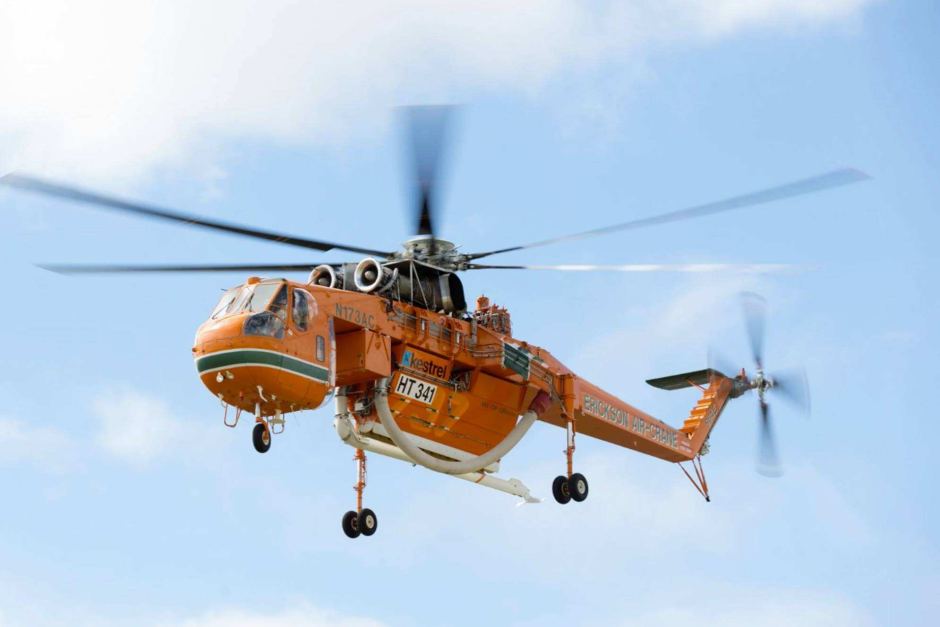
A helicopter crew has credited their surviving a collision with water with skills learned and practised as part of Helicopter Underwater Escape Training (HUET).
The 28 January 2019 accident occurred when Sikorsky S-64E Skycrane helicopter, registration N173AC, was conducting firebombing operations to the west of Thomson Dam in Victoria’s Yarra Ranges National Park. All three crewmembers were highly experienced, and twice during the day, they had utilised the nearby Wood Creek Dam to fill the helicopter’s tank using its pond snorkel.
On the day’s third visit to Wood Creek Dam, while descending with a nose-high attitude, the helicopter’s tail struck the water, which then submerged and resulted in the tail rotor detaching. The helicopter then rotated rapidly, its main rotor blades separated as they contacted water, the right cockpit door separated from the fuselage, and the helicopter came to rest on its left side, submerging the cockpit.
The crew would recall that it was not possible to see anything underwater, and that jet fuel contamination was present. Each recalled the rehearsed drills from their helicopter underwater escape training, and they identified their harnesses and nearest exit to orientate themselves in the aircraft. They all waited until the last moment to draw a breath, and did not unbuckle and attempt to exit the helicopter until motion had ceased.
One crewmember sustained a knee injury while the other two were uninjured. All three crew successfully exited the aircraft, inflated their life jackets, and swam to shore. The aircraft was substantially damaged.
Helicopters excel in confined areas, but are vulnerable when operating within them.
“The ATSB has previously emphasised the importance of helicopter underwater escape training,” ATSB Director Transport Safety Stuart Macleod said. “Indeed, in the wake of a separate, sadly fatal, accident the ATSB released a Safety Advisory Notice highlighting the importance of HUET regular training. This accident demonstrates the value of that training in saving lives.”
Mr Macleod noted that accident highlighted another survivability consideration, as neither pilot unplugged their helmet. However, the extension cords from the aircraft to the helmet plug allowed the plug to release, preventing the helmets from snaring them.
“Following an accident, it is common for air crew to overlook the need to unplug their helmet,” he said. “Using a good quality extension cable that will maintain the integrity of communications and release under tension in the event of an emergency can also save lives.”
The ATSB investigation into the accident established that, over the course of the day’s operation, the helicopter’s approach path to the dam was incrementally shortened. The length of the final approach was considerably shorter than earlier approaches.
ATSB investigators determined that it was likely that the final tight approach path was at the upper margins of allowable speed and angle of bank. This would have required a steep flare on arrival and likely resulted in the rapid onset of vortex ring* state.
“When performing aerial work, it is easy to accept incremental changes that gradually reduce margins. While these changes often increase efficiency, it is worth checking how much a sequence has deviated from earlier versions and re-evaluating elements if they appear less stable,” Mr Macleod said.
“Helicopters excel in confined areas, but are vulnerable when operating within them. In this case, the shape of the dam and surrounds of the site reduced the opportunity for recovery. Periodic reassessment of confined areas, and approach and departure profiles should be done throughout the duration of an operation.”
*Vortex ring state occurs when a helicopter descends into its downwash, where air recirculates back up and over the rotors instead of flowing down and away. This causes the same parcel of air to circulate around the rotor. As a result, the rotor system no longer has the steady stream of air required to produce lift and the helicopter will descend despite the application of additional power.
Read the final report: Collision with water involving a Sikorsky S-64E Skycrane helicopter, N173AC, near Jericho, Victoria, on 28 January 2019


